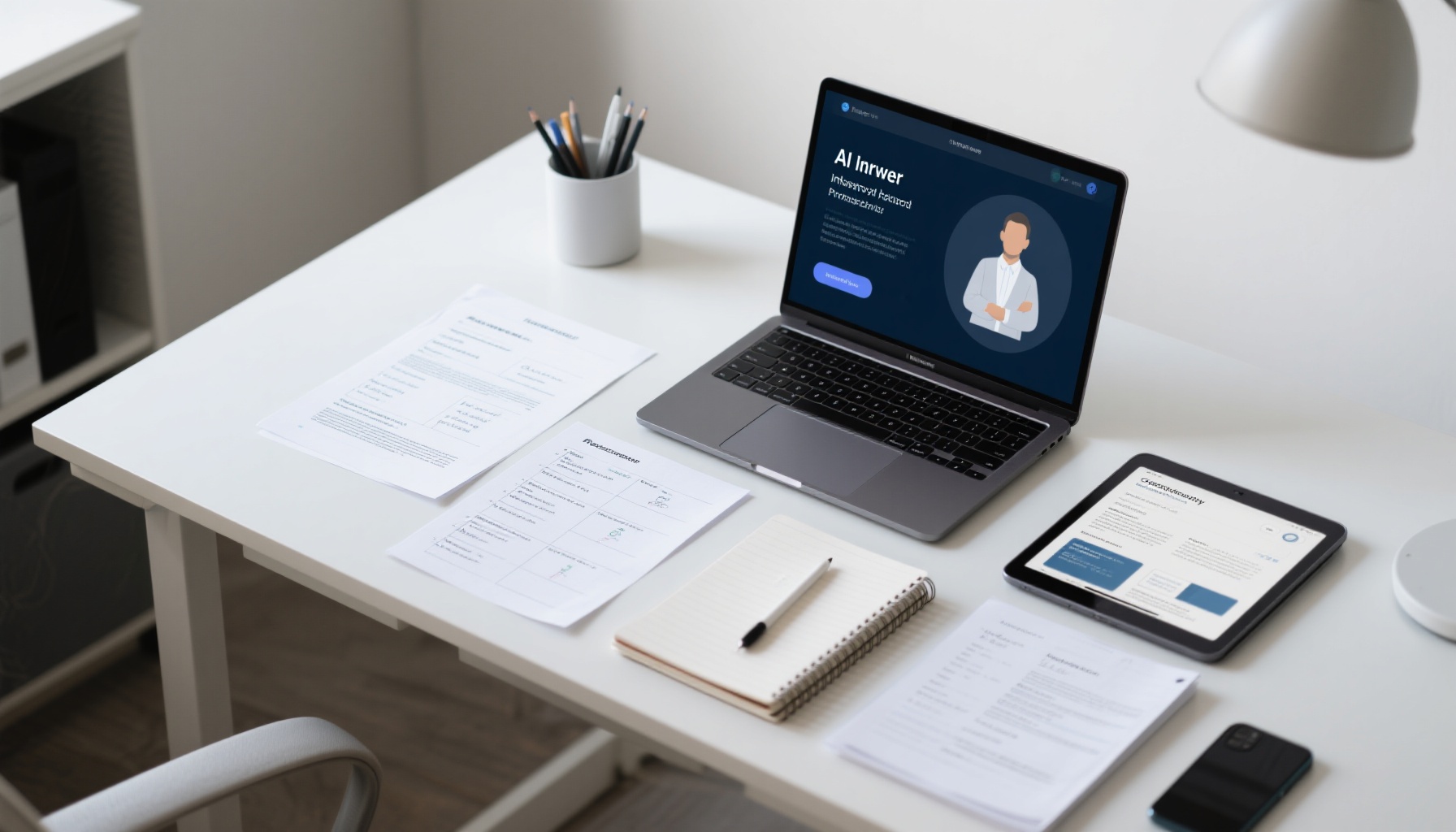The Ultimate Interview Practice Guide for 2025 (7 Actionable Methods)
Ready to practice an interview effectively? Discover 7 actionable methods to build confidence, reduce anxiety, and master your job interviews in 2025.

Job interviews can feel like walking into an unknown battlefield—your heart racing, palms sweating, and mind going completely blank the moment someone asks, "Tell me about yourself." You're not alone in this struggle. Even the most qualified candidates often stumble not because they lack skills, but because they haven't developed a systematic approach to interview preparation.
The truth is, effective interview practice isn't about memorizing perfect answers or cramming hundreds of potential questions. It's about building a repeatable framework that allows you to confidently communicate your value under pressure, no matter what curveballs come your way.

The Foundation: Understanding What Interviewers Really Want
Before diving into practice methods, it's crucial to understand what interviewers are actually evaluating. They're not just checking if you can recite your resume—they're assessing three core elements:
Can you do the job? This covers your technical skills, relevant experience, and problem-solving abilities.
Will you do the job? This examines your motivation, work ethic, and genuine interest in the role and company.
Will you fit? This evaluates your communication style, cultural alignment, and how you'll mesh with the existing team.
Every practice session should reinforce your ability to demonstrate these three pillars clearly and convincingly.
Method 1: Master the STAR Framework
The STAR method (Situation, Task, Action, Result) is your secret weapon for structuring compelling responses to behavioral questions. But most people use it wrong—they treat it like a rigid checklist rather than a storytelling framework.
Here's how to practice STAR effectively:
Start by identifying 5-7 core stories from your professional experience that showcase different competencies. These should include examples of leadership, problem-solving, teamwork, innovation, and overcoming challenges.
For each story, write out the STAR components, but focus heavily on the Action and Result sections. Your actions should be specific and demonstrate your thought process, while results should include quantifiable outcomes whenever possible.
Practice telling these stories out loud, timing yourself to keep each response between 1.5-2 minutes. The goal is to sound natural and conversational, not like you're reading a script.
Method 2: The Mirror and Record Technique
This might feel awkward at first, but practicing in front of a mirror while recording yourself is incredibly powerful for identifying and fixing delivery issues.
Set up your practice session:
Position yourself as if you're in an actual interview—good posture, appropriate distance from the "interviewer," and professional body language.
Record yourself answering common questions while maintaining eye contact with your reflection. This simulates the eye contact you'll need during the real interview.
When reviewing the recordings, listen for filler words (um, uh, like), pacing issues, and energy levels. Pay attention to your body language—are you fidgeting, slouching, or using distracting gestures?
Most people are surprised by what they discover in these recordings. You might find that you speak too quickly when nervous, or that your answers are longer than you realized.

Method 3: Research-Driven Question Anticipation
Generic interview question lists won't cut it. You need to anticipate questions specific to your industry, role level, and the particular company you're interviewing with.
Conduct targeted research:
Review the job description thoroughly and identify the top 3-4 competencies they're emphasizing. Prepare specific examples that demonstrate each one.
Research the company's recent news, challenges, and initiatives. Be ready to discuss how your skills can contribute to their current priorities.
Look up your interviewers on LinkedIn if possible. Understanding their background can help you tailor your communication style and find common ground.
Check platforms like Glassdoor for company-specific interview experiences, but don't rely on them entirely—interview processes evolve.
Create a list of thoughtful questions to ask your interviewers. This demonstrates genuine interest and gives you valuable information to make your decision.
Method 4: Simulate Real Interview Conditions
Practicing in comfortable, low-pressure environments is good for building basic skills, but you also need to practice under realistic conditions to build true confidence.
Create authentic pressure:
Schedule formal practice sessions at the same time of day as your actual interview. If it's a morning interview, don't practice only in the evenings.
Dress in your interview outfit during practice sessions. This helps you feel comfortable and confident in your professional attire.
Practice with video calls if your interview will be virtual. Test your technology, lighting, and camera angle beforehand.
Simulate the full interview timeline, including small talk at the beginning and time for your questions at the end.
Method 5: The Power of Mock Interviews with Real People
While solo practice is valuable, nothing replaces the unpredictability and real-time interaction of practicing with another person.
Maximize mock interview effectiveness:
Choose practice partners who will give you honest, constructive feedback—not just encouragement.
Provide your practice partner with the job description and sample questions so they can ask relevant, challenging questions.
Ask for specific feedback on your clarity, enthusiasm, and whether your answers actually address the questions being asked.
Practice the entire interview flow, not just individual questions. This includes your opening introduction, transitions between topics, and closing statements.
However, there's a significant limitation to relying solely on friends or family for mock interviews: they may not have the expertise to provide objective, professional feedback, and coordinating schedules can be challenging.

Method 6: Leverage AI-Powered Interview Practice
This is where modern technology can dramatically accelerate your preparation. While practicing with a friend is valuable, getting instant, unbiased feedback is a game-changer for serious interview preparation.
AI-powered interview platforms can provide the consistent, objective feedback that's often missing from traditional practice methods. For instance, using a platform like AceRound AI for mock interviews allows you to get real-time feedback on your answers, pacing, and delivery—helping you refine your performance on the spot.
The advantages of AI-assisted practice:
- 24/7 availability: Practice whenever it fits your schedule, without coordinating with others
- Instant feedback: Get immediate insights on your response quality, timing, and areas for improvement
- Unlimited repetition: Run through difficult questions multiple times until you master them
- Objective analysis: Receive unbiased feedback focused on performance, not personal relationships
- Real-time coaching: Get prompts and suggestions during your practice session to improve your answers
Think of it as having a personal interview coach available whenever you need it. The AI can help you identify patterns in your responses, suggest improvements, and track your progress over multiple practice sessions.
Method 7: Develop Your Personal Interview Toolkit
Your final preparation step is creating a comprehensive toolkit that you can reference and update for different opportunities.
Build your interview arsenal:
Create a "brag sheet" documenting your key accomplishments with specific metrics and outcomes. Update this regularly so you always have fresh examples.
Develop 3-5 go-to stories that can be adapted for different types of questions. A good leadership story, for example, might also demonstrate problem-solving or communication skills.
Prepare your elevator pitch—a compelling 60-90 second introduction that summarizes who you are professionally and what value you bring.
Practice your salary negotiation talking points, including your research on market rates and your value proposition.
Create a post-interview follow-up template that you can customize for each opportunity.

Putting It All Together: Your Practice Schedule
Effective interview preparation requires consistent practice over time, not cramming the night before. Here's a strategic timeline:
2-3 weeks before: Begin with research and STAR story development. Start solo practice sessions.
1-2 weeks before: Conduct mock interviews with others or AI platforms. Refine your stories based on feedback.
3-5 days before: Focus on company-specific preparation and final practice runs under realistic conditions.
Day before: Light review only. Focus on rest and mental preparation.
Transform Your Interview Anxiety into Confidence
The difference between candidates who excel in interviews and those who struggle isn't talent or qualifications—it's preparation. When you've practiced systematically using these seven methods, you'll walk into any interview knowing you can handle whatever comes your way.
Remember, the goal isn't to have perfect answers memorized. It's to develop the confidence and framework to communicate your value clearly and authentically, regardless of how the conversation unfolds.
Ready to take your interview preparation to the next level? Consider incorporating AI-powered practice into your routine with platforms like AceRound AI. With unlimited free mock interviews and real-time feedback, you can practice until you feel truly confident—because your dream job is worth the investment in proper preparation.
Your next interview doesn't have to be a source of anxiety. With the right preparation framework, it can be your opportunity to shine.



